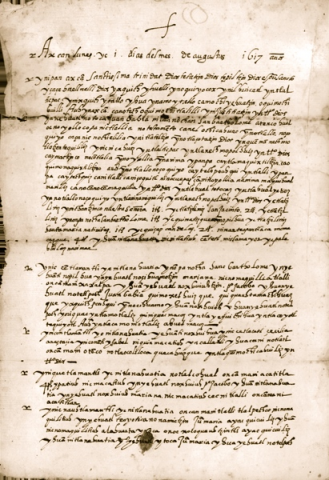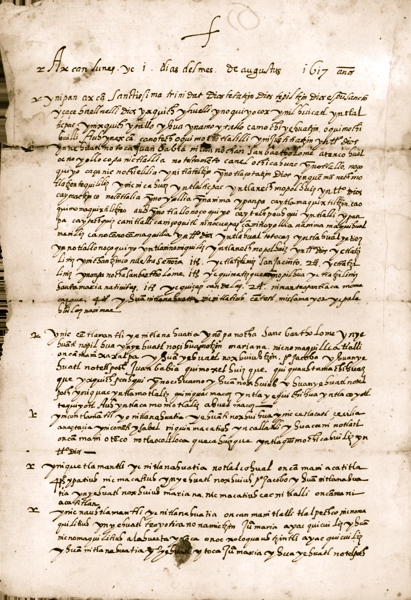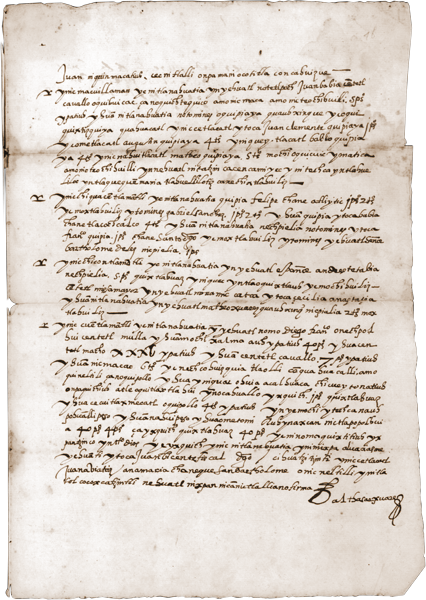Here we have a testament rich in detail and human interest as well as first person expression. Juan Fabián represents the type of commoners who worked as provincial traders, their fortunes often tied to local Spaniards who might provide credit, a mule, or some other advantage—as illustrated in the testament and related memoranda presented here.
Juan Fabián traded in the native zapote fruit, and his substantial holdings included orchards. He hired local residents to work for him and carpenters to make poles. He had a horse and several mules, along with pack gear and sacks, to transport the fruit to market. His son (also named Juan Fabián) and Diego Francisco, his son-in-law from the nearby town of San Mateo Churubusco (Huitzilopochco), were involved in the business too, taking the loaded pack trains to market. Some of the fruit must surely have been sold in San Mateo, where Diego Francisco’s personal ties would have been advantageous. In the end, however, the young men absconded with the goods—animals, pack gear, and cash—placed in their trust. Juan Fabián gives voice to his disappointment in his testament, calling his son a scoundrel and demanding repayment. He appends two memoranda detailing the accounts of Diego Francisco. It is here that we discover the extent to which Juan Fabián’s enterprises included borrowing and lending money with both Nahuas and Spaniards (up to five pesos) and that—other than the land—Juan Fabián’s most valuable possessions came from local Spaniards. The mule Diego Francisco lost belonged to Bartolomé Téllez, a member of a prominent local Spanish landowning family, and the horse he killed to the “Spaniard Fuente,” possible Antonio de Fuentes, the corregidor’s deputy, who was also heavily involved in local land transactions. In some ways, Juan Fabián was operating in a manner and on a scale comparable to many Spaniards on the fringes of the urban market economy.
The two memoranda (memorias) that accompany Juan Fabián’s testament detail the various obligations incurred by his son-on-law Diego Francisco for expenses related to the zapote fruit he had taken to sell, the loss of the pack animals, and other expenses related to the pack train. These records suggest that Juan Fabián kept written accounts of his business affairs in the Spanish fashion. Yet Juan Fabián was apparently illiterate and could hardly have produced such clean and sophisticated documents himself. Some indigenous person did so, but the memoranda have the air of having been prepared at a single time after the fact, doubtless with information Juan Fabián supplied, rather than kept on a current basis. In some fashion, whether in his head or through some system of marks and signs (of pre-conquest provenience or not), Juan Fabián was keeping precise track of a number of miscellaneous items of expense across significant periods of time. Sadly, we do not have image of the memorias to share at this time.
The testator had a substantial estate for a commoner; in his testament he bequeaths eight separate land parcels, one of them an orchard, a valuable property in early seventeenth-century central Mexico, that was likely the source of the zapote fruit he sold in neighboring towns. He divides his assets among children, wife, and grandchildren in the usual manner, though he also arranges things to allow for his mistrust of his son without absolutely disinheriting him, like leaving things to him along with his wife (that is, Juan Fabián’s daughter-in-law), a very unusual measure, and to be given to him only if he settles down on the property, a stipulation which actually is seen more often.
Juan Fabián’s holdings illustrate various characteristic features of a Nahua commoner’s landholdings, including the central pattern of holding house-land—here in the early seventeenth century it is still called callalli—along with other scattered properties. One property is also identified as tlalcohualli, “purchased land,” thus (implicitly) making the distinction between lands subject to tribute and other categories of land over which the household might exercise greater discretion. In addition, the testament identifies five parcels by toponym but none by tlaxilacalli; presumably all were located in Juan Fabián’s home district of San Bartolomé Atenco, a pattern characteristic of commoners in general.
Nahuatl bills of sale from Coyoacan often use the terms axcaitl and tlatquitl, both translated literally as possession or property, in reference to land. Juan Fabián’s testament also illustrates their use in reference to other types of property, specifically the eight sacks of zapote fruit his son-in-law was to sell: “amo ytlatqui amo iaxca,” “It is not his property, not his possession.”
Juan Fabián’s testament also illustrates the tendency for Nahuatl documents of Stage 2 to be more broadly witnessed than Spanish ones, the latter requiring three adult Spanish males as witnesses whereas the former often included women, community members, neighboring land owners, and so on. In Nahuatl documents the males were typically listed first with the women listed separately, often under the heading cihuatzitzintin, “the women,” as is the case here with the all-male executors of the estate, followed by the two women, Juana Beatriz and Ana María, called “cihuatzitzinti.“ One of the executors is the fiscal Juan Vicente, seemingly the same sort of substantial commoner as Juan Fabián and fiscal for the district church, not the whole altepetl.
The witness list, along with other individuals mentioned in the body of the testament, is what gives us a sense of Juan Fabián’s own status. We know he is a commoner (although more prosperous than the average) rather than being connected with the nobility—the testament mentions no municipal or other high-ranking offices, no relatives who carried the title don or doña, and no high-sounding surnames. In the testament and related memoranda Spaniards are either identified as such (“the Spaniard Andrés de Tapia”) or by the characteristic title señor; still others are known by name from the extensive body of research Rebecca Horn has carried out on Spaniards in the region.
Although in general the second name carried by ordinary Nahuas bore no relation to lineage, in the case of Juan Fabián, father and son, we see a not uncommon pattern where the child takes the entire name of the parent.
We also see that the fruit Juan Fabián sold is called in Nahuatl tzapotl, often translated zapote or sapota fruit, but as used in some texts it seems possible that the meaning was broader.
Testaments from lesser tlaxilacalli of Coyoacan sometimes have a very rustic aura, done by notaries less in the mainstream than those associated with the municipal council and the main church of the altepetl. Here we have an at least partial exception. Although the document is apparently done right in the tlaxilacalli of San Bartolomé, the notary, Baltasar Juárez, has not only a fine clear hand but overall a standard orthography. If the writer of a will is to demonstrate any eloquence, the place for him to do it is in the preamble and ritual formula, and Baltasar Juárez does so. Coyoacan already had a quite elaborate standard preamble, and the notary represents it fully, including the poetic phrase “God omnipotent who created the heaven, the earth, and everything visible and invisible.” And he elaborates on other phrases not always given that treatment: “if my earth and clay [my body] worsen, weaken, if I die, if our lord God effaces me, . . .”
Baltasar Juárez’s orthography is also generally very standard and correct, not betraying the constant unorthodoxies that we see in writers who were less carefully trained. He even shows some evidence of having been exposed to Latin, for instead of agosto for August he writes augustus, and justitia instead of justicia for “justice.” It is true that he consistently writes Fabián as Babia, but since Nahuatl lacked f as well as b, many writers treated them as equivalent. Sometimes in this document we see tl instead of l at the end of a syllable, as in “-tetlpoch” for standard -telpoch, “son,” implying that the writer’s pronunciation of the two consonants had merged when they were in final position.
The two memoranda concerning Diego Francisco are very well written but in a hand different and perhaps more modern than the testament by Baltasar Juárez. In the first memo, fur before “quitlexixil,” the word “quimicti,” “he killed it,” is marked out.
On the outside of the testament are the words “ytestame¯to Juo Phapia che . S . barme,” “the testament of Juan Fabián, citzen of San Bartolomé.”
[Introduction by James Lockhart.]
-----
Aquí tenemos un testimonio rico en detalles e interés humano, así como la expresión en primera persona. Juan Fabián representa la clase de comuneros que trabajaban como comerciantes provinciales, con sus fortunas que estaban, a menudo, ligadas a los españoles locales que podían proporcionar crédito, una mula, o alguna otra ventaja --- según el testimonio y memorandos relacionados que se presentan aquí.
Juan Fabián negocia con el fruto nativo, el zapote, y sus sustanciales propiedades incluyeron huertos. El contrató a los residentes locales para que le trabajaran a él y carpinteros para hacer pértigas. Tenía un caballo y varias mulas, junto con las alforjas y sacos para el transporte de la fruta al mercado. Su hijo (también llamado Juan Fabián) y su yerno, Diego Francisco, de la cercana ciudad de San Mateo Churubusco (Huitzilopochco), también estuvieron involucrados en el negocio, llevando las recuas cargadas al mercado. Alguna de la fruta debería de haber sido vendida en San Mateo, donde los vínculos personales de Diego Francisco habrían sido ventajosos. Sin embargo, al final, los jóvenes se fugaron con los productos y todos los bienes--- animales, alforjas con sacos para el transporte, y dinero en efectivo--- todo que lo fue colocado en su confianza. Juan Fabián da voz a su decepción en su testimonio, llama a su hijo un sinvergüenza y exige la devolución. Se añade dos memorandos que detallan las cuentas de Diego Francisco. Es aquí donde descubrimos lo tanto que las empresas de Juan Fabián incluyeron los préstamos de dinero (pedido y dado) tanto con Nahuas y españoles (hasta cinco pesos) y que-- aparte de las tierras-- las posesiones más valiosas de Juan Fabián vinieron de españoles locales. La mula que Diego Francisco perdió pertenecía a Bartolomé Téllez, un miembro de una familia prominente de terratenientes españoles locales, y el caballo que mató perteneció al "español Fuentes," posiblemente está refiriéndose a Antonio de Fuentes, el ayudante del corregidor, que también estaba muy involucrado en las transacciones de tierras locales. En cierto modo, Juan Fabián estaba operando de una manera y en una escala comparable a muchos españoles en la periferia de la economía del mercado urbano.
Los dos reportes (memorias) que acompañan al testamento de Juan Fabián detallan las diversas obligaciones contraídas por su yerno, Diego Francisco, y los gastos relacionados con la fruta zapote que él había tomado para vender, la pérdida de los animales de carga, y otros gastos relacionados con la alforja y los sacos de carga. Estos registros indican que Juan Fabián mantenía por escrito las cuentas de sus negocios al estilo español. Sin embargo, Juan Fabián era aparentemente analfabeto y no podía haber producido dichos documentos tan limpios y sofisticados por sí mismo. Algún indígena lo hizo, pero los memorandos tienen el aspecto de haber sido preparados de una sola vez después de los supuestos hechos, sin duda con la información suministrada por Juan Fabián, en lugar de haber sido escritos basados en lo ocurrido al momento. De alguna manera, ya sea en su mente o por medio de algún sistema de marcas y signos (de procedencia antes de la conquista o no), Juan Fabián estaba llevando la cuenta precisa de una serie de artículos diversos de los gastos a través de un amplio período de tiempo.
El testador tenía una finca bastante sustancial para un plebeyo; en su testamento lega ocho parcelas de tierra separadas, una de ellas un huerto, una propiedad valiosa a los principios del siglo XVII en el centro de México, y que era, muy probablemente, la fuente de la fruta de zapote que vendía en los pueblos vecinos. Se divide sus activos entre sus hijos, su esposa y sus nietos en la forma habitual, a pesar de que también organiza las cosas para permitir la desconfianza de su hijo sin desheredarlo por completo, como, por ejemplo, dejando las cosas ambos a su hijo y su esposa (es decir, la nuera de Juan Fabián), una acción muy inusual, y que se lo debe dar sólo si él se establece en la propiedad, una estipulación que en realidad se ve con más frecuencia.
Las posesiones de Juan Fabián ilustran varias características comunes de un plebeyo nahua terrateniente, incluyendo el patrón central de ser a la vez dueño de la casa y las tierras alrededores o el solar, que aquí a los principios del siglo XVII todavía se llama callalli - pero también de ser dueño de otras propiedades dispersas. Una de las propiedades también se identifica como tlalcohualli, “tierra comprada," por lo tanto (implícitamente) hace la distinción entre las tierras sujetas a tributo y otras categorías de tierras sobre las que la familia podía ejercer a su discreción. Además, el testamento identifica cinco parcelas por el topónimo, pero ninguno por tlaxilacalli; presumiblemente, todos estaban ubicadas en el distrito de San Bartolomé Atenco, el distrito de casa de Juan Fabián, un patrón característico de los comuneros en general.
Las facturas de venta náhuatl de Coyoacán a menudo usan los términos axcaitl y tlatquitl, ambos traducido literalmente como posesión o propiedad, en referencia a la tierra. El testamento de Juan Fabián también ilustra el uso de estos términos en referencia a otros tipos de propiedad, específicamente los ocho sacos de fruta zapote que su yerno debía de haber vendido: "amo ytlatqui amo iaxca", "No es su propiedad, no es su posesión. "
El testamento de Juan Fabián también ilustra la tendencia por los documentos náhuatl de la etapa 2 de ser más ampliamente atestiguado que los de los españoles, los últimos requieren tres adultos varones españoles como testigos, mientras que los primeros a menudo incluyeron a las mujeres, miembros de la comunidad, vecinos terratenientes, y así sucesivamente. En los documentos náhuatl se enumeran típicamente los hombres primero con las mujeres separada, muchas veces bajo el título cihuatzitzintin, "las mujeres", como es el caso aquí con los ejecutores varones de la finca, seguido por las dos mujeres, Juana Beatriz y Ana María, llamada "cihuatzitzinti." Uno de los ejecutores es el fiscal Juan Vicente, aparentemente el mismo tipo de comunero sustancial como Juan Fabián, y fiscal para la iglesia regional, pero no por todo el altépetl.
La lista de testigos, junto con otras personas mencionadas en el cuerpo del testamento, es lo que nos da una idea del estatus de Juan Fabián. Sabemos que es un comunero (aunque más próspero que el promedio) en lugar de estar conectado con la nobleza -- el testamento no menciona las oficinas municipales ni otras oficinas de alto rango, no hay parientes que llevaban el título de don o doña, ni presencia de apellidos de estatus social alto. En el testamento y las memorias relacionadas, los españoles están identificados como tales (“el español Andrés de Tapia") o por el título de respecto “señor”; otros son conocidos de nombre por la extensa investigación que Rebecca Horn ha llevado a cabo sobre los españoles en la región.
Aunque, en general, el segundo nombre llevado por los nahuas comunes no guardaba relación con el linaje, en el caso de Juan Fabián, padre e hijo, vemos un patrón algo conocido en el que el hijo toma el nombre completo del padre.
Vemos también que la fruta que vendía Juan Fabián se llama tzapotl en náhuatl, traducido a menudo como zapote o sapote, pero tal como se utiliza en algunos otros textos, parece posible que el significado era más amplio.
Testamentos de menor tlaxilacalli de Coyoacán a veces tienen un aura muy rústica, hecho por notarios menos en la corriente principal que los asociados con el ayuntamiento y la iglesia principal de altépetl. Aquí tenemos una excepción, al menos parcial. Aunque el documento se escriba aparentemente en tlaxilacalli de San Bartolomé, el notario, Baltasar Juárez, no sólo tiene una calígrafa bien clara, pero en general una ortografía estándar. Si el autor de un testamento quiere demostrar alguna elocuencia, el lugar para que él lo haga es en las formulas del preámbulo y ritual, y Baltasar Juárez lo hace. Coyoacán ya tenía un preámbulo estándar bastante elaborado, y el notario lo representa en su totalidad, incluyendo la frase poética "Dios omnipotente quien creó el cielo, la tierra, y todo lo visible e invisible." Y él se elabora sobre otras frases que en general no recibieron ese tratamiento tan poético: "si mi tierra y arcilla [mi cuerpo] empeoran, debilitan, si muero, si nuestro Señor Dios me borra, … “
La ortografía de Baltasar Juárez también es en general muy estándar y correcta, no traiciona las heterodoxias constantes que vemos en los escritores que fueron entrenados con menos cuidado. Incluso muestra algunas evidencias de haber sido expuesto al latín, porque en vez de usar agosto, escribe augustus y justitia en lugar de justicia. Es cierto que él constantemente escribe Fabián como Babia, pero como el náhuatl carecía f así como b, muchos escritores los trataron como equivalentes. A veces, en este documento vemos tl en lugar de l al final de una sílaba, como "-tetlpoch" para el estándar -telpoch, "hijo", lo que implica que la pronunciación del autor de las dos consonantes se había fusionado cuando estaban en la posición final.
Los dos testimonios relativos a Diego Francisco están muy bien escritos, pero con una mano diferente y quizás más moderno que el testamento de Baltasar Juárez. En la primera nota, piel antes "quitlexixil", la palabra "quimicti", "lo mató," está marcada.
Al exterior del testamento están las palabras "ytestamēto Juo Phapia che. S. barme ","el testamento de Juan Fabián, ciudadano de San Bartolomé ".
[Introducción por James Lockhart; traducción al español de la introducción por Melanie Hyers.]



